Holding onto Hoxha: Guarding the last statue of communist Albania
In the basement of an old museum in a village in Albania, a 78-year-old woman protects the last remnant of a dictator.
![Enver Hoxha - Albania feeature [Fatjona Mejdini]](/wp-content/uploads/2020/05/d2cec3c0120446e8a43e3e957f9495e1_18.jpeg?resize=770%2C513&quality=80)
Labinot and Tirana, Albania – Sabire Plaku is suspicious of every stranger who sets foot in her remote village of Labinot in central Albania.
If she sees a visitor, or hears of their presence, the 78-year-old halts whatever she is doing and rushes from the house she shares with her daughter, past a garden of vegetables, fruit trees and wandering hens, towards what used to be the village museum.
Keep reading
list of 4 itemsVladimir Putin sworn in for fifth term as Russian president
What’s at stake in Chad’s presidential election?
Why South Africa’s opposition may struggle to unseat the ruling ANC
Her shoulders slumped in a loose navy blue jacket with free-hanging sleeves, Sabire stops and gasps for breath. Although her house overlooks the former museum, she has to walk 100 metres before climbing up a steep, muddy slope to reach it.
For the last three decades, she has served as the guardian of the two-storey abandoned structure in the centre of Labinot, and the three-metre-tall (10-foot-tall) bronze statue that lies hidden in its basement – a statue of Albania’s first communist chief of state, Enver Hoxha.
The former dictator brutally ruled the small southeastern European country from the end of World War II until his death in 1985. Dozens of depictions of him stood across the country during that time, but now, the one Sabire so cautiously guards is the last undamaged statue that remains.
Labinot, in the Elbasan municipality, is home to about 6,000 people. The road that takes you there – like those inside the village – is steep, narrow and poorly maintained. People rely on agriculture and livestock to make a living, while many youngsters temporarily immigrate to Greece and Italy to find work.
Residents are wary, especially of people scoping out the old museum. Over the years, those opposed to Hoxha’s legacy have vandalised the site on moral grounds, while others have tried to steal the statue to use for scrap metal.
But once the villagers are sure a visitor does not have any “sinister” intentions, they invite them home for coffee or lunch. When asked about Labinot’s past, their eyes light up and a burst of energy seems to fill their bodies.
A heavy burden
In 1943, when Albania was occupied by Italian fascists, communist partisans used mountainous Labinot as one of their war bases and, in March of that year, held the first national Communist Party conference there.
This conference became a keystone for Hoxha’s political career. There, he was chosen as the new leader of Albania’s communists, which opened the way for their rein over Albania during the four decades that followed. A few months later, the National Liberation Army – a body that helped intensify the communist resistance until the end of the occupation – was also formed in Labinot.
Both historical events were held in the house Sabire now devoutly guards, a house that after the war turned into a museum to document the village’s past.
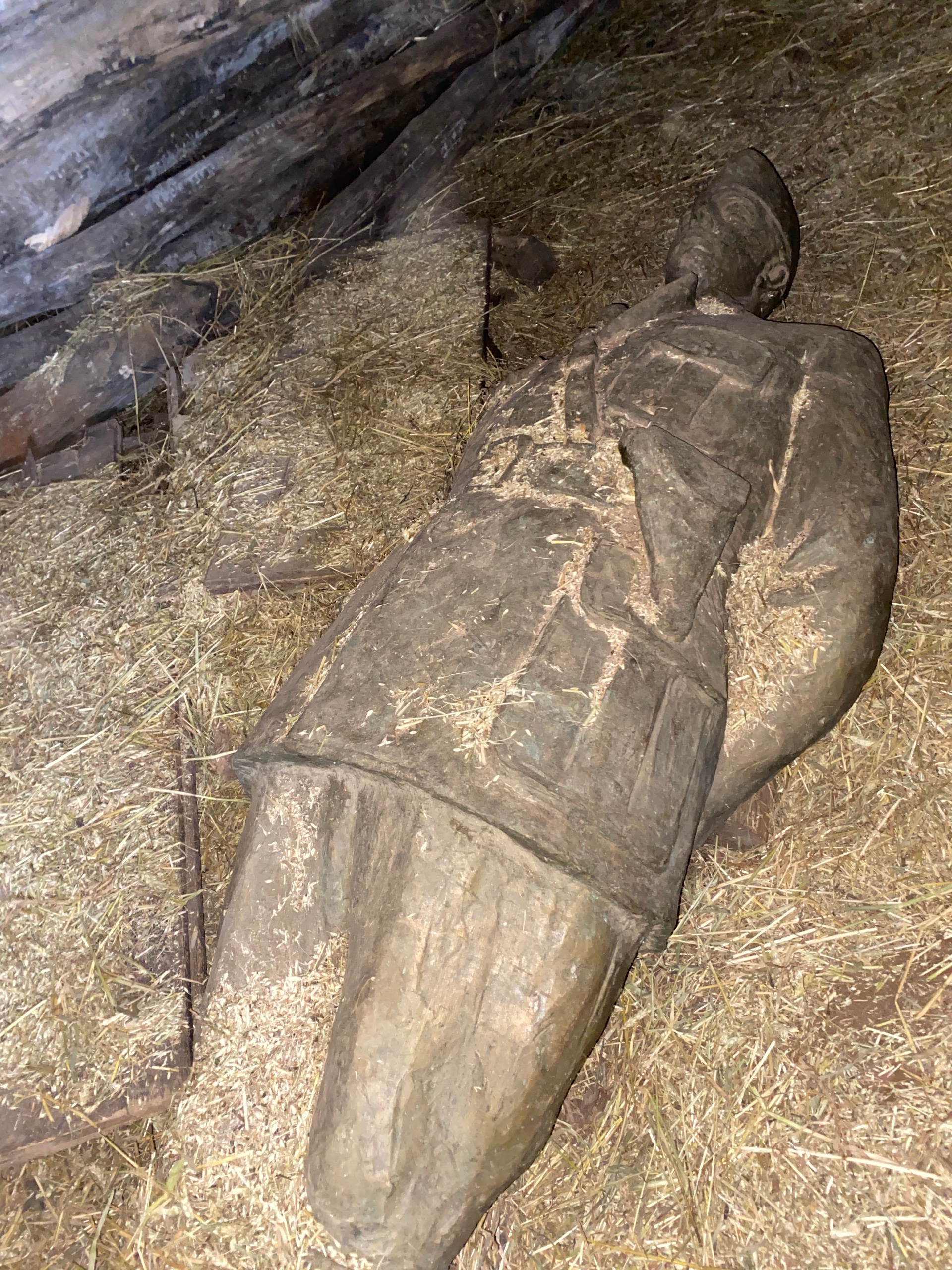
In 1968 during the commemoration of the 25th anniversary of the uprising, the statue of the young Hoxha in military attire was erected in front of the museum.
In 1991, when communist rule collapsed in Albania, the museum closed its doors and Hoxha’s statue was brought down.
But it was left to the villagers to decide what to do with it. Instead of getting rid of it, they shielded it in the basement, without imagining that it would remain there for decades to come.
Sabire, encouraged by her fellow villagers, felt a moral duty to safeguard both the house and the statue, in memory of her late husband who, during his lifetime, served as the museum’s administrator.
Sabire does not mention politics. When asked about the reason she continues to guard the dictator’s statue, she looks up, as if amazed by the question itself, and replies: “I cannot just toss it away … “
But as the years pass, and with the threats from burglars and vandals, she knows it is an increasingly difficult task.
“Keeping the house and the statue safe for all these years has been emotionally draining and very challenging,” she says. “I have been supported by my neighbours as well, but the biggest responsibility has been on me.”
Sabire walks slowly, with a limp. She feels the guardian role is becoming a heavy burden and one that will be difficult to carry for much longer. She looks forward to the day the authorities take the house administration into their own hands and find a place for the statue in the basement.
“I haven’t kept the house and the statue safe for myself, they belong to the state and I want to hand them over as soon as possible. It is time for them to act and tell us what they want to do,” she says.
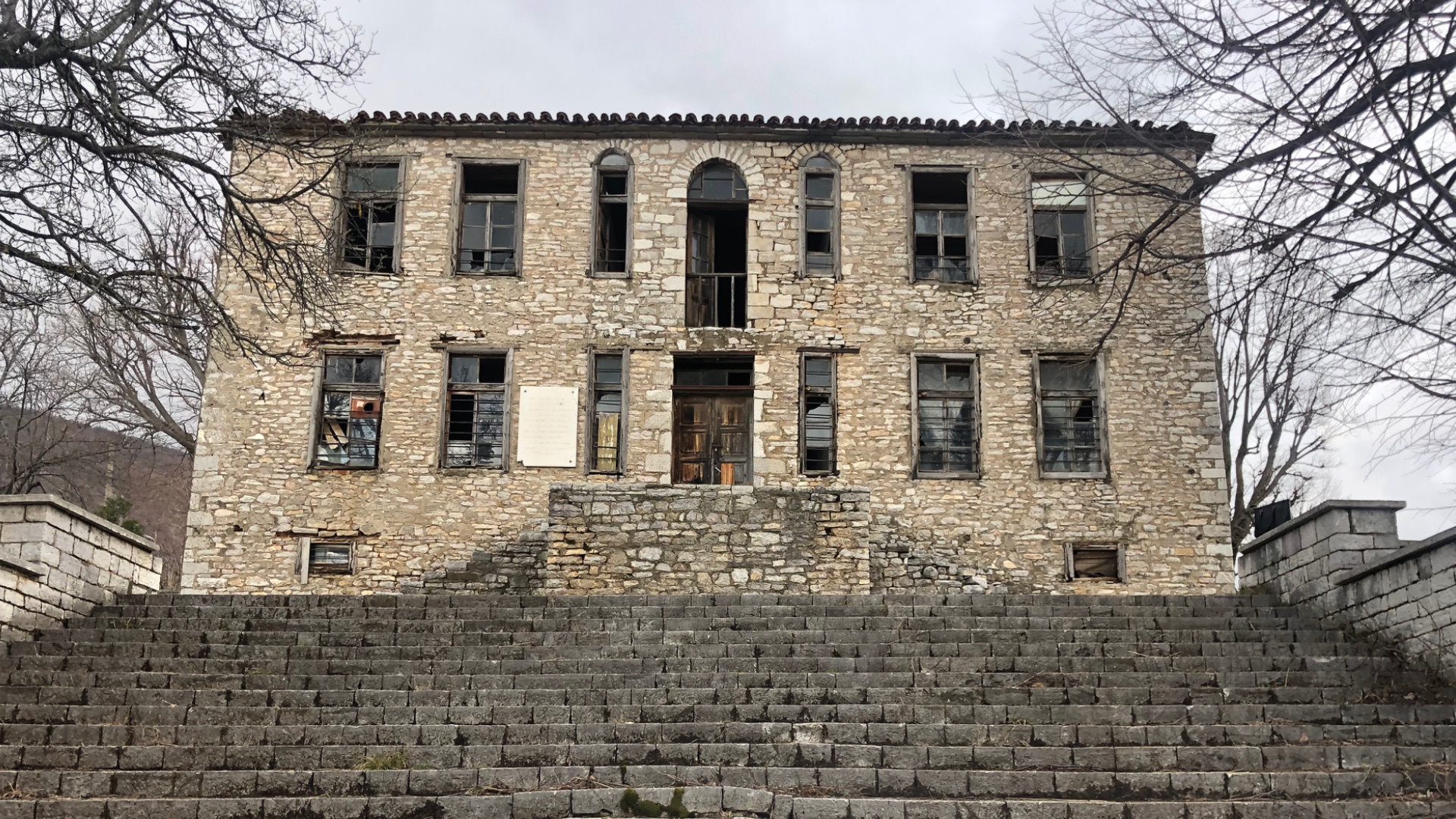
Labinot’s former museum house, built at the beginning of the 20th century, is officially listed as a cultural monument. The two-storey stone villa stands stately at the centre of the village, so different from the buildings surrounding it that it gives the impression of having been transposed from another time.
Designed by Italian architects in the 1920s the house belonged to a wealthy (Baholli) family from Elbasan, serving as their summer estate. At the beginning of the 1940s, the family helped the anti-fascist resistance and donated the house to the National Liberation Army.
Now its main entrance is locked, but from the cracks in the wooden door, you can see its wide, empty hallways and collapsed staircase. Once upon a time, its walls displayed pictures of historical events, letters and ammunition used in the war against the fascists. Now the memory of what it once was is held up by nothing more than the fallen Hoxha statue, that can only be accessed by an inconspicuous little back door.
The dictator cult
In February, Albania’s Institute of Cultural Monuments, acknowledging the risk of the museum falling apart as a result of time, approved a restoration plan. But it is not clear when the work will begin.
When it comes to finding a place to house the statue, things get more complicated. No institution seems to want to lift the heavy burden of a bronzed Hoxha.
In the capital Tirana, some 70km (43 miles) from Labinot, the back of Albania’s National Gallery of Art is the only possible place where the statue could be moved. There, a shabby bust of Hoxha with a broken nose already stands, nearly hidden beside statues of Lenin and Stalin.
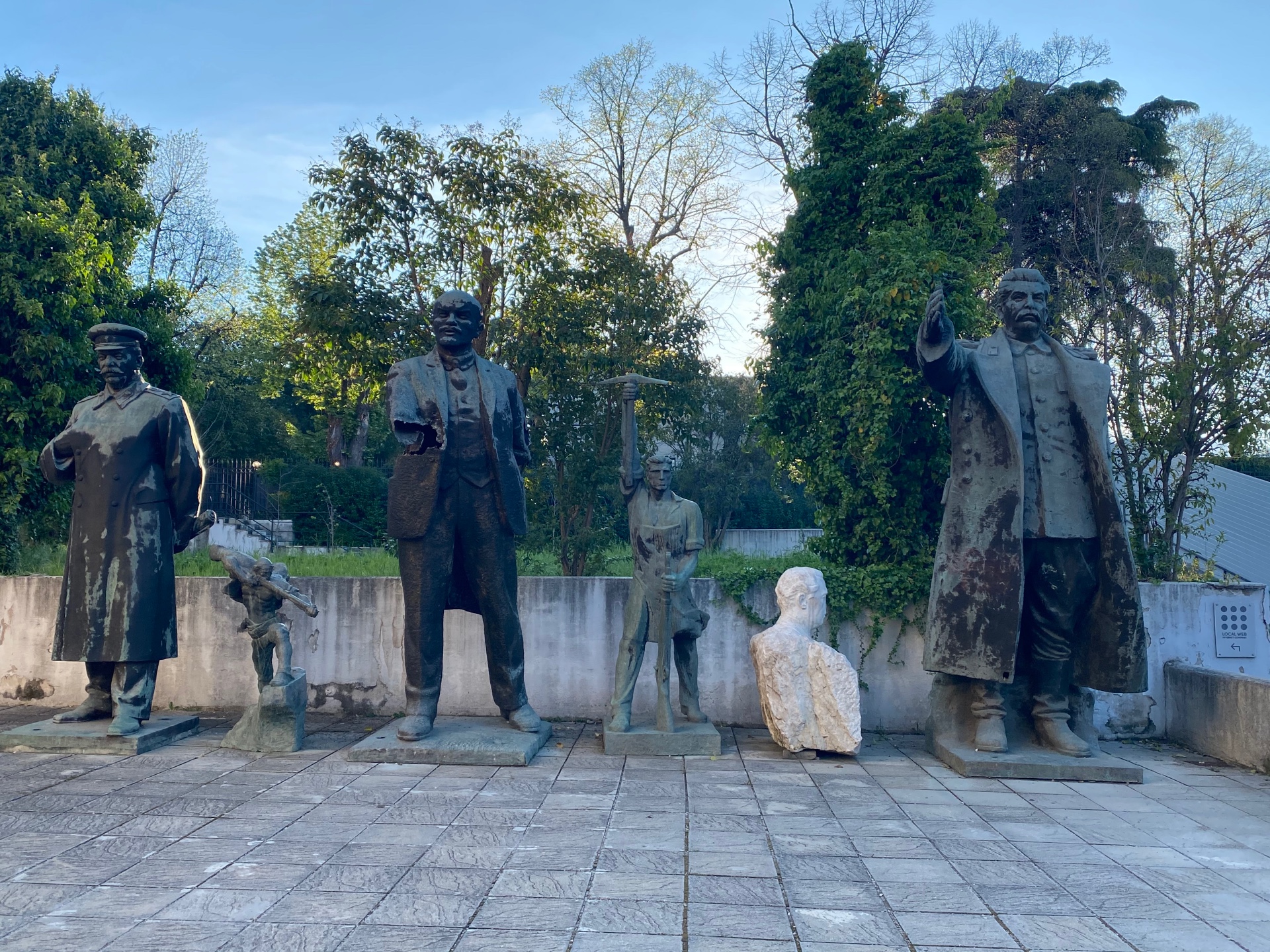
Hoxha was inspired and hugely influenced by Stalin.
Ideas that streamed from the Bolshevik revolution and were implemented by Lenin and later Stalin – including the creation of a one-party state and purging by any means one’s political enemies – appealed to Hoxha. He was also drawn to the creation of a “dictatorship of the proletariat” – where the working class holds political power and nationalises the means of production.
Following in their footsteps, Hoxha embraced a centralised economy where industry and other economic activities were owned by the state. Marxism-Leninism was taught in Albanian schools, while busts of Stalin were erected in many cities.
Within a short period of time, Hoxha became the absolute leader of the Communist Party (later renamed the Party of Labour of Albania) and of Albania. During his four decades in power, he prosecuted and ruthlessly eliminated every real or imagined political opponent.
Albanian communism was built on the cult of a dictator. The regime Hoxha created, isolated Albanians from the rest of the world and brought to an end not only their political freedoms but also their personal ones. People would be jailed and their families deported to internment centres. Nobody was immune.
In 46 years of its existence, the regime displaced more than 30,000 Albanians to labour camps and internment areas. About 18,000 others were imprisoned for political reasons and 6,000 were executed, many without trial. Today there are more than 4,000 people still missing – many of whom are thought to have been buried in mass graves.
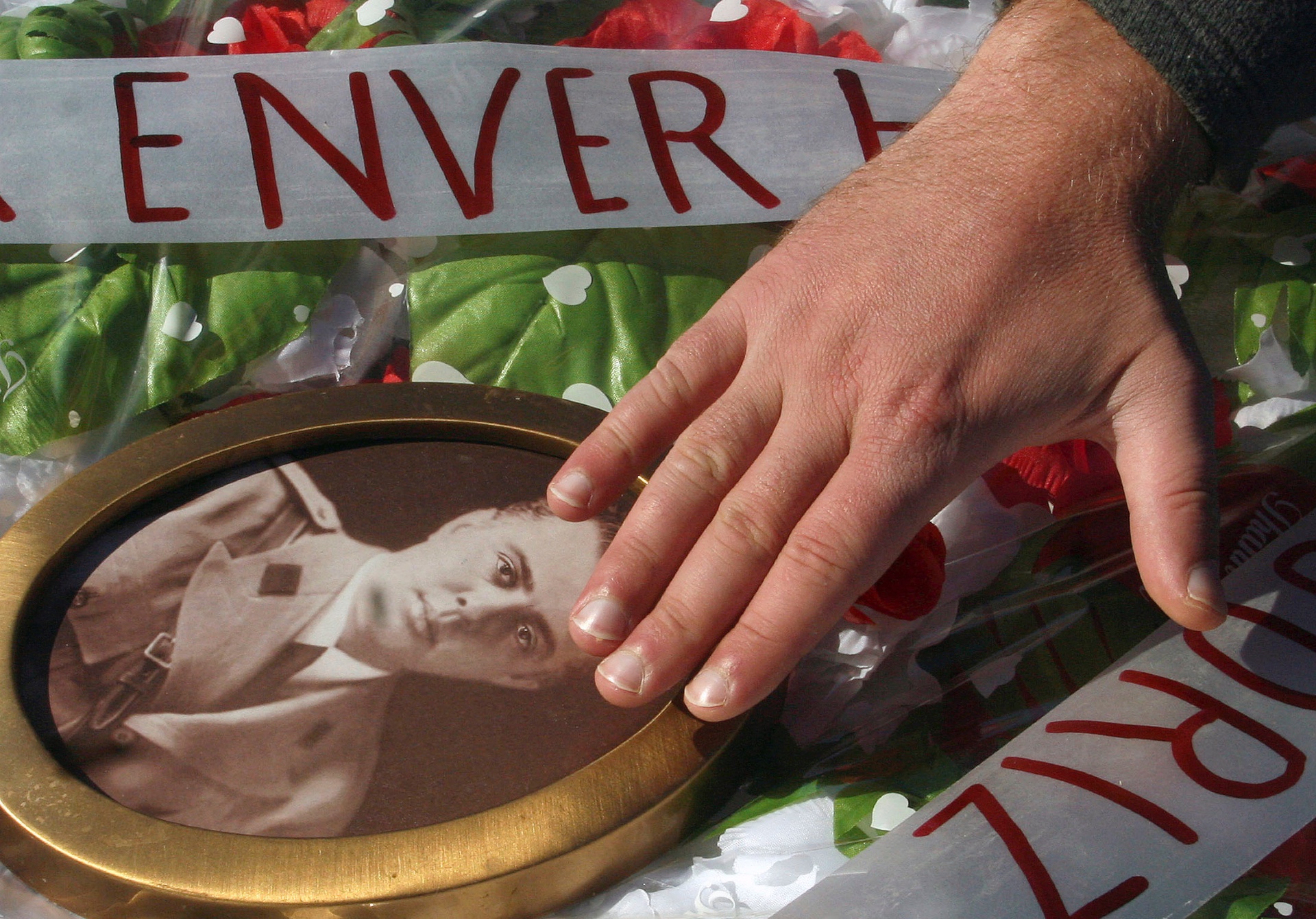
In order to consolidate the violent regime, the Party created a sophisticated machine of propaganda dissemination, driven by the glorification of its leader, Hoxha.
Radio, newspapers and television would describe him as the “legendary commander” who was building a new and better Albania inspired by Marxist-Leninist ideology.
Ideas such as the need to eliminate the classes in society, the need to give everyone the same chances and a secure job, and the need to protect the country from foreign enemies, especially the “evil” West, were used to justify the violence.
Immortalising Hoxha’s legacy
Hoxha was at the forefront of efforts to build his cult of personality. He wrote a total of 71 books – 13 of which are memoirs – forging and twisting many elements of his life and the country’s history. Alternative sources of information were simply not available.
His obsession with power without rivals led to unprecedented hostility toward religion. Imams, priests and other spiritual leaders were imprisoned and killed.
In 1967, Hoxha called on Albanians to take a stand against religion and tens of thousands obeyed, demolishing more than 2,000 religious places of worship throughout Albania. Mosques and tekkes, Orthodox and Catholic churches were vandalised and turned into communist propaganda offices, cultural centres or warehouses. In 1976 the practising of religion was banned by the Constitution and communists took pride in establishing what they called “the first atheist country in the world”.
In April 1985, Hoxha died at the age of 77, from complications caused by diabetes, but the Party was prepared to save the power he had accumulated. They felt the cult of Hoxha should not end with his life and in order to keep it alive, new tools were introduced.

Maks Velo was a painter and architect who was accused by the communists of spreading propaganda through art, and subsequently jailed for 10 years in 1978 when he was 43. He passed away this month at age 85, but spoke to Al Jazeera before his death, explaining how the communists relied on visual arts in order to immortalise the legacy of their deceased leader.
“After Hoxha’s death, artists were asked to create numerous busts, statues and memorials portraiting the dictator. These creations aimed to further glorify his cult and were characterised by falsity, giant mania and lack of artistic sense,” Maks said.
For a long time, local artists turned to “propaganda tools and [were] stripped from the real artistic senses, so they remained at the regime’s disposal, and served its political aims”, he added.
Soon the statues of Hoxha were erected in squares and at the institutional doors of Albania’s main cities. Busts were used to decorate every state office and their replicas also appeared in the living rooms of ordinary Albanians.
More ambitious projects were undertaken in Hoxha’s birth town of Gjirokaster and the capital Tirana. A monument, with a statue of Hoxha seated in its centre, was built in a panoramic terrace at the entrance to Gjirokaster. Around 80 tonnes of Italian marble was used to build it. After the fall of communism in Albania in 1991, this same memorial was smashed to pieces.
In Tirana in 1988, a 12-metre-tall (39-foot-tall) statue of Hoxha was erected in the main Skerderbej square. That same year, the doors of the Pyramid opened – a massive building alongside Tirana’s main boulevard destined to house a museum to memorialise the dictator’s life. To this day, it remains one of the most iconic buildings in the Albanian capital.
The downfall
As part of a general effort to keep the cult of the dictator alive, immediately after his death, the University of Tirana was named after him. Ironically, in December 1990, the students of this university became the first to protest against the regime, taking to the streets and chanting for “freedom and democracy”.
Their massive protests opened the way to political pluralism and the Democratic Party of Albania was formed that same month.
However, in February 1991, students resumed their protests, this time asking for the removal of communist symbols, starting with the name “Enver Hoxha”, from their university. Faced with the authorities’ refusal to do so, 726 of them began a hunger strike on February 18.
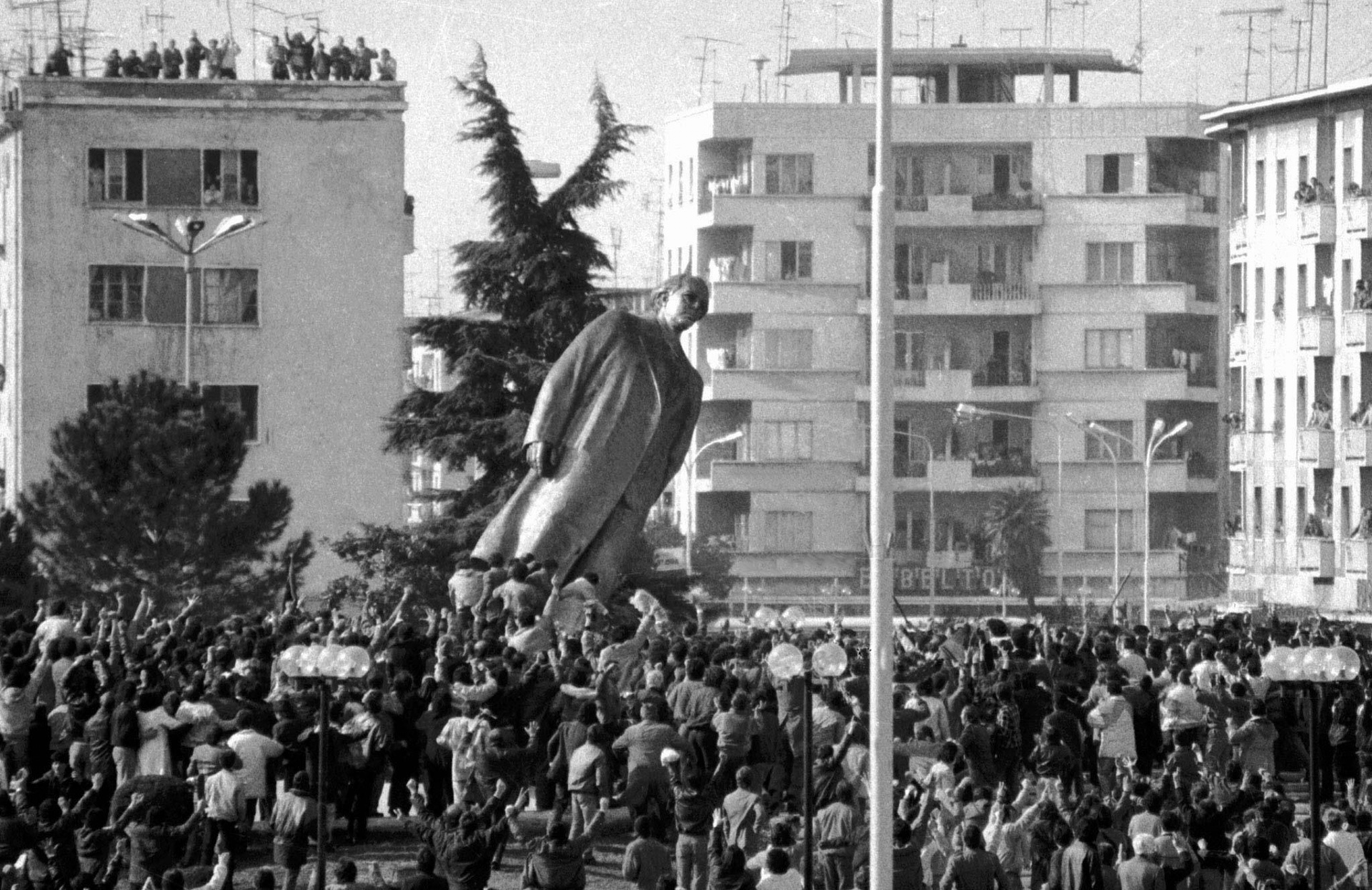
Blendi Gonxhja, at that time a rebellious 21-year-old student at the University of Arts, led this historical strike. Their resistance created huge solidarity, with hundreds of thousands students and citizens across the country protesting in support of them.
“The popular support for students’ strike grew fast and became so big that it swept Tirana’s streets and led to a massive gathering in ‘Skenderbej’ square. The rage there just became impossible to be contained,” Blendi recalls.
Citizens had decided to take down the communist symbols themself. Hundreds of thousands of them angrily took aim at the 12-metre-tall statue of Hoxha in this square, looped a robe around its neck and pulled it down amid unbridled enthusiasm from the crowd.
After a while – they dragged it for two kilometres (1.2 miles) – they brought the statue to the doors of the building where students were holding their hunger strike.
“They brought the statue to our feet, it was unbelievable. The message was clear: the democracy could not grow under the shade of the dictator cult,” Blendi says.
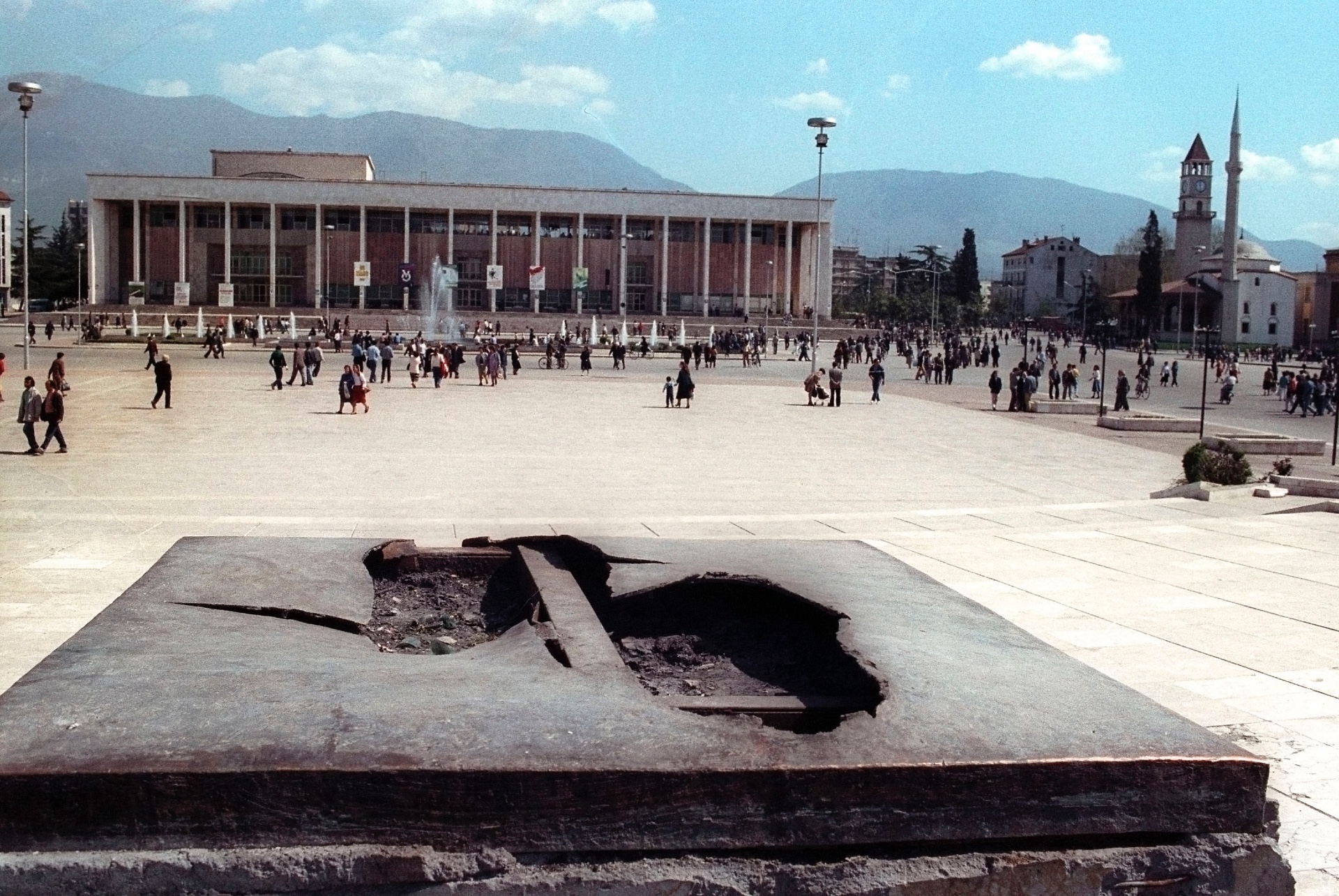
That night, authorities took the decision to remove the name of Enver Hoxha from the university. February 20 entered the history books and in 2010 the date was declared the remembrance day for victims of the crimes of communism.
Meanwhile, years later, part of the bronze from Hoxha’s statue in Tirana was privately sold by an Albanian sculptor to a German colleague. It was recast into a small statue of German physicist Georg Christoph Lichtenberg, which now stands in a market place in the city of Gottingen.
Reckoning with the past
Back in Labinot, the villagers are aware of communism’s crimes and feel sorry for the pain that many of their compatriots had to endure. Their eagerness to revive a house haunted by memories of an inglorious past feels more like a homage to their good lives under the regime.
Back then, communism turned the remote village into a reputable centre where people had secure jobs, schools, healthcare, museums and thousands of visitors every year, they say.
Shefqet Burraj, 62, recalls that time with enthusiasm, but it vanishes quickly when he talks about the present.
“The roads that take you here are crumbling, we haven’t seen any infrastructural investment in these three decades, authorities seem to have forgotten our existence. Our children need to immigrate in order to secure a living,” he complains.
But the sense of nostalgia expressed by some for their “secure lives under communism” opens wounds for many others.
Uran Kostreci, an 82-year-old poet who spent 20 years in regime prisons for trying to escape the country, feels that communist crimes were never fully condemned in Albania and the people who ordered them were not held accountable.
“The trials at the beginning of ’90s against high officials of the regime were a farce and nobody was convicted [for] more than five years. The Lustration was never fully implemented and none of the architects of that inhumane regime showed ever any repentance,” he says.

Between 1993 and 1994 more than 20 former high officials of the Party of Labour, including the dictator’s widow, Nexhmije Hoxha, were charged with corruption and misusing public funds. Although they were convicted and sentenced from three to 11 years in prison, appeal courts reduced their sentences and none remained in jail for more than five years. Nexhmije Hoxha left the prison in January 1997.
In 1996, another group, which included Hoxha’s successor as head of the Party, Ramiz Alia, faced trial for crimes against humanity, including genocide charges. Although some were found guilty, a year later an appeal court nullified those sentences and set them free.
In 2016, Albania established the Authority for Access to Information on Ex-Sigurimi Files in order to collect and declassify the files of the communist-era secret service, “Sigurimi”, and make them available to those who were spied on and the general public.
Sigurimi was an infamous and much-feared structure that had in its disposal 15,000 collaborators fully committed to spying on anyone deemed suspicious, helped also by a large network of volunteers.
Thousands of those who were persecuted have already asked to retrieve their files, while others have experienced the great shock of learning that close friends and relatives once spied on them on behalf of Sigurimi.
‘A historical mistake’
Poet and former prisoner Uran Kostreci considers the opening of the files a positive step towards the truth; although, like many others, he believes this process started too late.
Once a week, in the former headquarters of Sigurimi, now turned into a museum, he speaks to high school students about communism in Albania.
“They are smart and eager to learn but unfortunately they know very little about that time. The school curriculums never have fully explained the atrocities that happened and most importantly the impact that they had on Albanians,” Uran says.
Blendi Gonxhja, now a state official, believes that to this day the country has not reflected on everything that went wrong during communist rule, and says Albanian society lacks awareness of the real price that was paid for “that historical mistake”.
As a result, he feels, many of the problems of the past re-emerged even though the system had collapsed.
“The change of the system didn’t bring the democratic values that people were looking forward to. As in the old time, these three decades were characterised by violence and violation of human rights; political discrimination and revenge; the unification of the party with the state and many more,” he says.
Furthermore, people who had contributed to some of the most criminal aspects of the past regime were returned to public offices, including Albania’s parliament.
Blerina Gjoka, the director of the Kujto (Remember) foundation that archives crimes of communism, says it “is shameful that those who prosecuted innocent people continued to have an active role in the country public life, though [they] never apologised”.
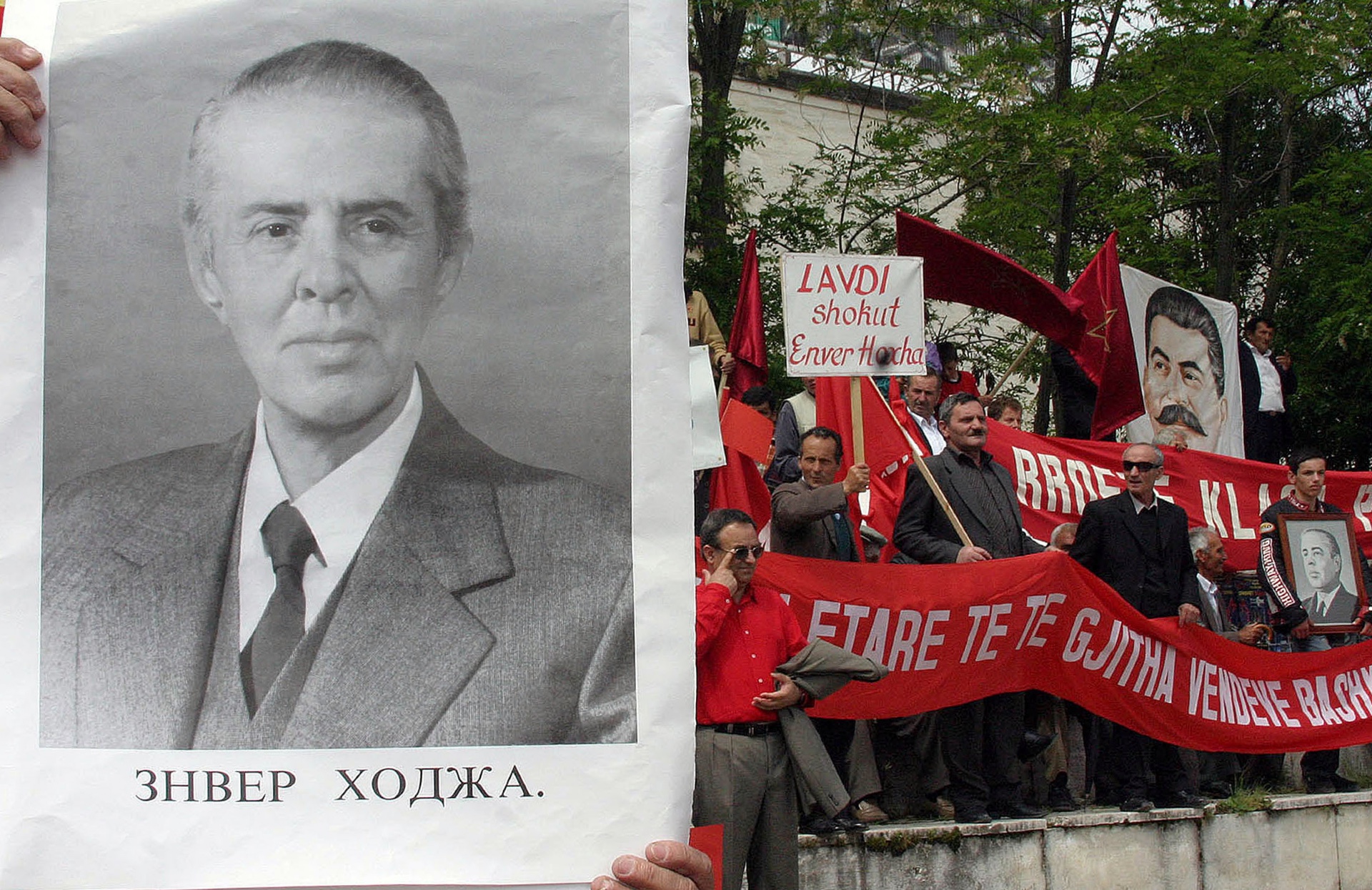
Although communism in Albania was one of the harshest in Eastern Europe, leaving a long trail of misery and tens of thousands of deaths, the public display of its symbols was never banned.
Uran encounters, on a daily basis, pictures of the dictator and his communist cronies, streets and schools that held the names of his friends’ persecutors, and continuing efforts to revise the true story of the country’s painful past.
Elsewhere, groups of communist “nostalgics” commemorate events like Martyrs’ Day or Hoxha’s date of birth, holding signs with a picture of the dictator and displaying communist symbols like red five-pointed stars.
On TV, old movies that glorify communism are still broadcast, while online, the pages and forums that worship Hoxha’s legacy are numerous.
And in Labinot, Sabire does not know how long she will have to take care of Hoxha’s statue, while waiting for the state to collect it. But she is committed to regularly climbing the steep, muddy slope to check on it for as long as she can.
“Paradoxically, in today’s Albania you can openly honour a criminal regime, but there is not a memorial to honour its victims,” Gjoka says.
“To this day the families of those persecuted still don’t have a place where to lay flowers in memoria of their sufferings.”